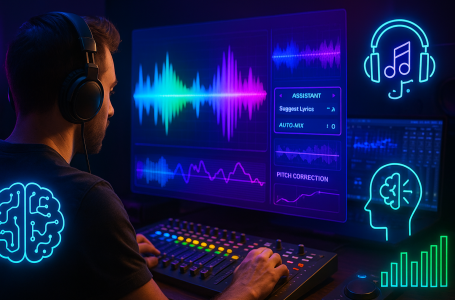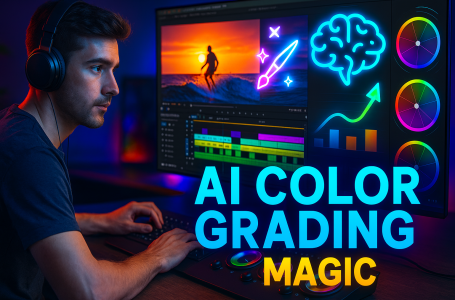
Creating videos used to require expensive equipment, years of training, and countless hours of editing. Today, AI video generators are changing everything. Whether you’re a YouTuber cranking out weekly content, a marketer creating product demos, or an educator building online courses, AI tools can transform your workflow from overwhelming to manageable.
AI Video Generator
Meet Sarah, a typical AI video generator. She runs a digital marketing agency and creates about 20 videos per week – everything from client explainer videos to social media ads. Her morning starts with generating AI avatars for a training course, then she’s editing product demonstrations, and by afternoon, she’s creating personalized video messages for email campaigns.
AI video generators like Sarah wear many hats. They’re part content strategist, part technical operator, and part creative director. Their daily toolkit includes avatar creation platforms, text-to-video generators, automated editing software, and voice synthesis tools. They’re not traditional videographers – they’re efficiency experts who leverage AI to scale video production beyond what any human team could accomplish manually.
The core tasks revolve around speed and personalization. Sarah might use AI to generate 50 different versions of the same product video, each tailored to different customer segments. She creates avatar-based training modules that can be updated instantly when company policies change. Her social media videos get generated from blog posts with just a few clicks, and her client presentations feature AI-generated visuals that would have taken graphic designers days to create.
But this workflow comes with unique challenges. Rendering bottlenecks can kill productivity when working with multiple AI tools simultaneously. Hardware limitations mean some creators can’t run the latest models locally. Tool overload is real – with hundreds of AI video platforms launching monthly, choosing the right stack becomes overwhelming.
Here’s where AI tools become game-changers. Instead of spending hours filming and editing, Sarah inputs text and gets polished videos. Rather than hiring voice actors, she generates natural-sounding narration in minutes. When clients need last-minute changes, she updates AI parameters instead of reshooting entire sequences.
Take her recent project: a series of 30 onboarding videos for a SaaS company. Traditional production would have required weeks of planning, filming, and editing. Using AI tools, she generated the entire series in two days. The AI avatar maintained consistency across all videos, the generated voiceovers sounded natural, and automated editing ensured professional pacing throughout.
System Configuration
Your hardware determines which AI video tools you can run effectively. The difference between smooth creativity and frustrating lag often comes down to having the right specs.
For optimal performance, aim for 32GB RAM minimum. AI video generation is memory-intensive – models load entire neural networks into RAM, and video files consume additional memory during processing. Many creators start with 16GB and quickly hit limitations when running multiple tools or processing longer videos.
GPU requirements vary dramatically by tool. NVIDIA RTX 4070 or higher handles most local AI video generation comfortably. The RTX 4090 represents the sweet spot for serious creators – enough power for real-time generation without the expense of professional workstation cards. AMD GPUs work with some tools but have limited compatibility compared to NVIDIA’s CUDA ecosystem.
CPU matters more than many realize. Modern 8-core processors like Intel i7-13700K or AMD Ryzen 7 7700X provide good baseline performance. However, 12-core or 16-core options significantly reduce rendering times, especially when running multiple AI processes simultaneously.
Storage needs are substantial. A 1TB NVMe SSD is minimum – AI models alone can consume 100GB+, and video projects quickly fill remaining space. Many creators adopt a dual-drive setup: fast NVMe for active projects and larger traditional drives for archived content.
Internet connectivity becomes crucial for cloud-based tools. Minimum 100 Mbps upload speeds prevent bottlenecks when processing videos through cloud platforms. Many AI video tools require constant internet connectivity, making reliable connection speeds essential for professional workflows.
Don’t worry if your system falls short of these ideals. Cloud-based tools level the playing field. Platforms like RunwayML and Synthesia run entirely in browsers, requiring only decent internet connections. A modest laptop with 8GB RAM can access the same AI capabilities as high-end workstations through cloud processing.
Top 10 AI Tools for Video Generation
1. Synthesia
Synthesia revolutionizes avatar-based video creation for AI video generators who need consistent, professional-looking presenters. Instead of appearing on camera or hiring actors, creators generate realistic AI avatars that deliver scripted content with natural gestures and expressions.
This tool specifically helps AI video generators scale personalized content. Sarah uses Synthesia to create training videos where the same avatar delivers consistent messaging across dozens of modules. When content updates are needed, she modifies the script rather than re-filming entire sequences.
Minimum requirements are surprisingly low: 4GB RAM, standard dual-core processor, and modern web browser. Synthesia runs entirely cloud-based, making it accessible to creators with basic hardware setups.
The importance for AI video generators lies in consistency and scalability. Traditional video requires re-shooting when presenters are unavailable or content changes. Synthesia avatars are always available, maintain consistent quality, and can deliver content in multiple languages without accent variations.
Key features include 120+ AI avatars, 65+ languages, custom avatar creation, branded templates, and API integration for automated workflows. The platform handles everything from corporate training to marketing videos, with professional results that match traditional video production quality.
2. RunwayML
RunwayML serves as the creative powerhouse for AI video generators who need advanced editing capabilities beyond basic generation. While other tools focus on specific tasks, RunwayML provides a comprehensive suite for video manipulation, creation, and enhancement.
AI video generators leverage RunwayML for complex projects requiring multiple AI techniques. Sarah uses it to remove backgrounds from footage, generate missing video segments, and apply style transfers that would require expensive post-production work. The platform’s strength lies in combining multiple AI capabilities within single workflows.
System requirements scale with usage: 8GB RAM for basic features, 16GB for advanced processing, and dedicated GPU recommended for local model runs. However, cloud processing options accommodate users with limited hardware.
This tool’s importance stems from its versatility. Instead of switching between multiple platforms for different AI video tasks, creators access everything through RunwayML’s interface. This reduces workflow complexity and maintains project consistency.
Key features encompass text-to-video generation, video-to-video style transfer, object removal, motion tracking, and collaborative editing tools. The platform regularly updates with cutting-edge AI models, keeping creators at the forefront of video AI capabilities.
3. HeyGen
HeyGen specializes in AI avatar videos with emphasis on business communication and marketing applications. While similar to Synthesia, HeyGen focuses specifically on commercial use cases with features tailored for marketing teams and content creators.
AI video generators choose HeyGen for creating promotional content, product demonstrations, and customer communication videos. The platform excels at generating videos that feel personalized while maintaining professional polish required for business applications.
Minimum system requirements include 4GB RAM, modern web browser, and stable internet connection. Like most avatar platforms, HeyGen operates through cloud processing, making hardware limitations less restrictive.
The tool’s importance lies in its marketing-focused features. Templates, branding options, and integration capabilities streamline commercial video production. For creators generating client content or promotional materials, HeyGen provides the professional presentation quality clients expect.
Key features include instant avatar creation, voice cloning, multi-language support, branded video templates, and bulk video generation. The platform’s strength is rapid production of professional-quality promotional content without traditional filming requirements.
4. Pictory
Pictory transforms text content into engaging videos, perfect for AI video generators who need to repurpose written content quickly. Blog posts, articles, and scripts become polished videos with minimal manual intervention.
This tool specifically benefits creators who manage content across multiple formats. Sarah uses Pictory to convert client blog posts into social media videos, transforming written content into visual stories that engage audiences more effectively than text alone.
System requirements are minimal: 4GB RAM, standard processor, and reliable internet connection. Pictory’s cloud-based architecture ensures accessibility regardless of local hardware limitations.
The importance for AI video generators is content multiplication. Instead of creating separate written and video content, creators leverage existing text to generate video versions automatically. This approach maximizes content value while minimizing production time.
Key features include automatic video creation from text, stock footage integration, AI voiceovers, customizable templates, and social media optimization. Pictory excels at maintaining narrative flow while selecting appropriate visuals to support textual content.
5. Lumen5
Lumen5 focuses on social media video creation, helping AI video generators produce platform-optimized content efficiently. The tool understands social media requirements and automatically formats videos for different platforms.
AI video generators rely on Lumen5 for consistent social media presence without manual video editing. The platform analyzes content and suggests optimal video structures, pacing, and visual elements for maximum engagement on specific social platforms.
Minimum requirements include 4GB RAM, modern web browser, and stable internet connection. Browser-based operation eliminates hardware barriers while maintaining professional output quality.
This tool’s importance lies in social media expertise. Creating effective social media videos requires understanding platform-specific best practices, optimal lengths, and engagement triggers. Lumen5 incorporates this knowledge automatically.
Key features encompass platform-specific templates, automatic text-to-video conversion, stock media libraries, brand customization, and analytics integration. The platform streamlines social media video production while maintaining platform optimization.
6. InVideo
InVideo provides comprehensive video creation capabilities with strong AI features for creators who need flexibility beyond specialized tools. The platform combines traditional editing with AI assistance for versatile video production.
AI video generators use InVideo when projects require custom editing alongside AI generation. Sarah leverages its AI features for initial content creation, then uses traditional editing tools for fine-tuning that specialized platforms can’t provide.
System requirements vary by feature usage: 8GB RAM recommended, modern processor, and dedicated graphics helpful but not required. Browser-based operation with local processing options accommodates different hardware configurations.
The tool’s importance stems from balancing AI automation with creative control. While specialized tools excel at specific tasks, InVideo provides flexibility for projects requiring both AI efficiency and manual refinement.
Key features include AI video generation, extensive template library, stock media access, collaborative editing, and export optimization for multiple platforms. InVideo bridges the gap between fully automated and manually crafted video content.
7. Fliki
Fliki specializes in text-to-video conversion with emphasis on natural-sounding AI voices and appropriate visual selection. The platform excels at creating narrated videos from written content with minimal user input.
AI video generators choose Fliki for projects requiring high-quality narration combined with relevant visual content. The tool’s strength lies in matching voice tone with visual elements to create cohesive storytelling experiences.
Minimum system requirements include 4GB RAM, standard web browser, and reliable internet connection. Cloud processing ensures accessibility while maintaining output quality regardless of local hardware specifications.
This tool’s importance is in narrative video creation. Many AI video tools generate visuals effectively but struggle with natural-sounding narration. Fliki’s voice synthesis quality rivals professional voiceover work while maintaining consistency across projects.
Key features encompass realistic AI voices, automatic visual selection, multi-language support, customizable pacing, and brand voice options. Fliki excels at creating professional narrated content without traditional recording requirements.
8. Steve AI
Steve AI offers animated video creation specifically designed for business applications, helping AI video generators produce professional animated content without animation expertise.
This platform benefits creators who need animated explainer videos, product demonstrations, or educational content. Steve AI’s templates and automation eliminate the complexity typically associated with animation while maintaining professional results.
System requirements include 8GB RAM recommended, modern processor, and stable internet connection. Browser-based operation with cloud rendering accommodates various hardware configurations while ensuring consistent performance.
The tool’s importance lies in making animation accessible. Traditional animation requires specialized skills and significant time investment. Steve AI democratizes animated video creation for business applications.
Key features include animated character libraries, business-focused templates, automated scene generation, voiceover integration, and collaborative editing capabilities. The platform streamlines animated video production for commercial applications.
9. Wzp AI
Wzp AI focuses on short-form video creation optimized for social media platforms, particularly TikTok, Instagram Reels, and YouTube Shorts. The tool understands short-form video dynamics and creates content accordingly.
AI video generators leverage Wzp AI for consistent short-form content creation without the time investment typically required for effective short videos. The platform’s algorithms optimize for engagement patterns specific to short-form platforms.
Minimum requirements are modest: 4GB RAM, modern browser, and good internet connection. Mobile-friendly interface allows content creation from various devices while maintaining quality standards.
This tool’s importance stems from short-form video expertise. Creating effective short videos requires understanding rapid engagement triggers, optimal pacing, and platform-specific features. Wzp AI incorporates these elements automatically.
Key features include short-form templates, trending audio integration, automatic captioning, platform optimization, and viral content analysis. The platform specializes in creating short videos that perform well on social media algorithms.
10. Colossyan
Colossyan provides AI video creation with focus on educational and corporate training applications. The platform offers features specifically designed for instructional content and professional communication.
AI video generators choose Colossyan for creating training materials, educational content, and corporate communications. The tool’s features align with learning objectives and professional presentation requirements rather than entertainment or marketing applications.
System requirements include 8GB RAM recommended, modern processor, and reliable internet connection. Cloud-based processing ensures accessibility while maintaining the professional quality required for educational applications.
The tool’s importance lies in educational focus. While many AI video tools target marketing or entertainment, Colossyan understands instructional design principles and incorporates them into automated video creation.
Key features encompass educational templates, interactive elements, assessment integration, multi-language support, and learning management system compatibility. Colossyan bridges AI video generation with educational effectiveness.
Comparison Table
| Tool | Min RAM | CPU | GPU Needs | Avatar Creation | Video Editing | Voice Synthesis | Social Media | Learning/Training | Notes |
|---|---|---|---|---|---|---|---|---|---|
| Synthesia | 4GB | Dual-core | None (cloud) | Excellent | Basic | Excellent | Good | Excellent | Best avatar consistency |
| RunwayML | 8GB | Quad-core | Recommended | Good | Excellent | Good | Excellent | Good | Most versatile features |
| HeyGen | 4GB | Dual-core | None (cloud) | Excellent | Basic | Excellent | Excellent | Good | Marketing-focused avatars |
| Pictory | 4GB | Dual-core | None (cloud) | None | Good | Good | Excellent | Good | Best text-to-video |
| Lumen5 | 4GB | Dual-core | None (cloud) | None | Good | Basic | Excellent | Basic | Social media specialist |
| InVideo | 8GB | Quad-core | Helpful | Basic | Excellent | Good | Excellent | Good | Balanced features |
| Fliki | 4GB | Dual-core | None (cloud) | None | Basic | Excellent | Good | Excellent | Best voice quality |
| Steve AI | 8GB | Quad-core | None (cloud) | Good | Good | Good | Good | Excellent | Animation specialist |
| Wzp AI | 4GB | Dual-core | None (cloud) | Basic | Good | Basic | Excellent | None | Short-form expert |
| Colossyan | 8GB | Quad-core | None (cloud) | Excellent | Basic | Excellent | Basic | Excellent | Education-focused |
Beginner vs Intermediate vs Expert Recommendations
| Experience Level | Recommended Tools | Reasoning | Key Focus Areas |
|---|---|---|---|
| Beginners (0-1 years) | Lumen5, Pictory, Fliki | These tools require minimal learning curve and provide excellent results with simple inputs. Browser-based operation eliminates technical barriers while built-in templates ensure professional output. | Template usage, basic customization, understanding AI tool capabilities |
| Intermediate (1-3 years) | Synthesia, HeyGen, InVideo, Steve AI | Mid-level creators need more customization options while maintaining efficiency. These tools balance automation with creative control, allowing skill development without overwhelming complexity. | Custom branding, workflow optimization, multi-tool integration |
| Expert (3+ years) | RunwayML, Colossyan, InVideo + API integrations | Advanced users maximize efficiency through tool combinations and custom workflows. These platforms provide extensive features and integration capabilities for complex projects. | API usage, custom workflows, advanced feature utilization |
Beginner justification: New creators benefit most from tools that produce professional results immediately. Lumen5’s social media focus, Pictory’s text conversion, and Fliki’s voice quality provide strong foundations for learning AI video creation without technical frustration.
Intermediate justification: Creators with some experience need tools that grow with their skills. Synthesia and HeyGen offer avatar customization options, while InVideo provides editing flexibility. Steve AI introduces animation capabilities at manageable complexity levels.
Expert justification: Advanced creators require maximum flexibility and integration capabilities. RunwayML’s comprehensive feature set, Colossyan’s specialized applications, and API integrations enable custom workflows that maximize productivity for complex projects.
Do’s and Don’ts for AI Video Generators
| Do’s | Don’ts |
|---|---|
| Test multiple tools before committing to paid plans. Each platform has strengths suited to different project types. | Don’t rely on single tools for all projects. Different tasks require different AI capabilities for optimal results. |
| Maintain consistent branding across all AI-generated content. Upload brand assets and create style guides. | Don’t ignore brand consistency when switching between platforms. Inconsistent presentation damages professional credibility. |
| Optimize scripts for AI voices using natural language patterns and appropriate pacing cues. | Don’t use complex sentences or technical jargon that AI voices struggle to pronounce naturally. |
| Plan video structures before generation. AI tools work best with clear content organization and flow. | Don’t expect AI to fix poor planning. Disorganized input creates disorganized output regardless of tool quality. |
| Regularly update and backup your custom templates, avatars, and brand assets across platforms. | Don’t lose custom assets by failing to backup configurations when switching tools or upgrading systems. |
| Monitor output quality and adjust parameters based on audience feedback and engagement metrics. | Don’t set-and-forget AI generation settings. Regular optimization improves results over time. |
| Learn platform-specific features that can streamline your particular workflow and project types. | Don’t use tools generically. Each platform has unique features that maximize efficiency when properly utilized. |
| Combine multiple AI tools strategically to leverage each platform’s strengths for complex projects. | Don’t overcomplicate workflows by using multiple tools when single platforms could achieve the same results. |
Summary
AI video generation tools have transformed content creation from a time-intensive craft into an efficient, scalable process. These platforms enable creators to produce professional-quality videos without traditional filming, editing expertise, or expensive equipment. Whether you’re generating avatar presentations, converting text to video, or creating platform-optimized social media content, AI tools provide the efficiency and quality modern content demands require.
The beauty of current AI video technology lies in its accessibility. While high-end hardware enhances performance, cloud-based platforms ensure that creators with modest systems can access the same capabilities as those with powerful workstations. This democratization means creativity and strategy matter more than technical resources, leveling the playing field for content creators worldwide.
Success with AI video generation comes from matching tools to tasks rather than trying to force single platforms into every workflow. Specialized tools like Synthesia excel at avatar creation, while RunwayML provides comprehensive editing capabilities. Understanding each platform’s strengths and limitations ensures optimal results while maximizing productivity and maintaining professional quality standards.
Quick Checklist
✅ System Ready?
- RAM meets minimum requirements for chosen tools
- Internet connection supports cloud processing
- Storage space allocated for projects and assets
✅ Picked the Right Tools?
- Tools match your primary content types
- Feature sets align with your skill level
- Budget accommodates necessary subscriptions
✅ Matched Tool to Task?
- Avatar videos: Synthesia or HeyGen
- Text conversion: Pictory or Fliki
- Social media: Lumen5 or Wzp AI
- Complex editing: RunwayML or InVideo
✅ Saved Your Comparison List?
- Bookmarked platforms for future reference
- Noted pricing and feature differences
- Identified backup options for each use case
✅ Tried At Least 2 Platforms?
- Tested free trials or versions
- Compared output quality for your content
- Evaluated workflow integration potential








